Lock Picking Guide: Which Lock is Easiest to Pick
2024-11-06 08:47
Lock picking is often portrayed as an intricate art in movies and literature, where skilled thieves can effortlessly bypass security systems. In reality, while some locks are designed to be highly secure, others are relatively easy to pick. Understanding which locks are easier to pick can be beneficial for locksmiths, hobbyists, or even those looking to improve their security awareness. In this article, we’ll explore the easiest lock to pick and the techniques involved.

Understanding Lock Mechanics
Before diving into specific locks, it’s essential to grasp the basic mechanics of how locks function. The most common type of lock is the pin tumbler lock, which consists of a cylinder and a series of pins of varying lengths. When the correct key is inserted, the pins align with a shear line, allowing the cylinder to turn and unlock the mechanism.
The art of lock picking lies in manipulating these pins without the original key. By using Lock Pick Sets such as torque wrenches and crowbars, a locksmith can apply pressure to the lock and lift the pins individually to the correct height.
The Easiest Lock to Pick: The Simple Padlock
Among various types of locks, simple padlocks are often cited as the easiest to pick. These locks typically have fewer pins and simpler internal mechanisms, making them more accessible for beginners. Let's break down why padlocks are relatively easy to pick and how to approach the task.
Design Simplicity: Most basic padlocks feature a straightforward pin tumbler design. They often have only four or five pins, compared to more complex locks that may have up to eight or more. This simplicity reduces the number of combinations a picker has to deal with.
Low Tolerance: Many inexpensive padlocks have low manufacturing tolerances, which means that even slight misalignments in pin height can lead to the lock opening. This makes it easier to manipulate the pins during the picking process.
Commonly Available Tools: The tools required to pick a padlock are widely available and inexpensive. A basic lock pick set usually includes a tension wrench and a few different picks, which are all you need to start picking simple padlocks.
.jpg)
Techniques for Picking a Simple Padlock
If you’re interested in trying your hand at lock picking, here’s a step-by-step guide on how to pick a basic padlock.
Gather Your Tools: You’ll need a Tension Wrenches and a pick. A tension wrench provides the necessary pressure to hold the pins in place as you manipulate them.
Insert the Tension Wrench: Place the tension wrench in the bottom of the keyhole. Apply slight pressure in the direction you would turn the key. This tension is crucial, as it holds the pins in place once they are lifted to the shear line.
Insert the Pick: With the tension wrench in place, insert your pick into the lock. Gently push the pick upwards, feeling for the pins inside.
Feel for Binding Pins: As you push the pins up, you’ll notice that some pins may bind tighter than others. Focus on lifting these binding pins first. This is often the key to success.
Lift the Pins: Using your pick, lift the binding pins one at a time until you hear a faint click. This indicates that the pin has cleared the shear line.
Maintain Tension: While lifting the pins, ensure you maintain tension on the wrench. If the tension is released, the pins will fall back into place, making it necessary to start over.
Continue Picking: Repeat the process until all the pins are set above the shear line, allowing the lock cylinder to turn and unlock.
Legal and Ethical Considerations
Before attempting lock picking, it’s important to understand the legal and ethical implications. Lock picking should only be practiced on locks that you own or have explicit permission to manipulate. Using these skills for illegal purposes can lead to serious legal consequences.

Conclusion
While many locks are designed with security in mind, the simple padlock stands out as one of the easiest to pick. With the right tools and techniques, beginners can quickly learn the basics of lock picking. However, always remember to approach this skill responsibly and ethically, focusing on locks you have permission to pick. Whether for personal curiosity or professional locksmithing, mastering the art of lock picking can be both an engaging and educational endeavor.

 Like Us on Facebook to enjoy 5% discount
Like Us on Facebook to enjoy 5% discount